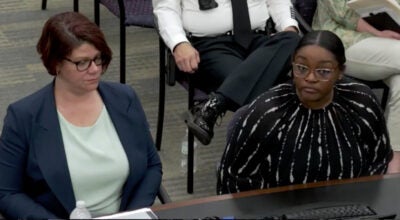Mayoral candidates Alexander, Heggins discuss ‘Fame,’ protesting, pandemic
Published 12:10 am Sunday, October 24, 2021
By Natalie Anderson
natalie.anderson@salisburypost.com
SALISBURY — Karen Alexander and Al Heggins both confronted the issue of relocating the “Fame” Confederate monument during their tenures as mayors and agree events in 2020 and subsequent safety concerns made relocation possible.
In addition to events surrounding the pandemic, a swath of the sitting council’s term was defined by protests for racial justice and police accountability after the death of George Floyd in 2020 and a renewed call to relocate the “Fame” Confederate monument from its downtown perch. Alexander, the city’s current mayor, and Heggins, the city’s mayor pro tem, spoke to the Post about the issues.
Relocation of “Fame”
Conversations about relocating the monument in 2020 weren’t new. After the monument was vandalized with paint in August 2018 and March 2019, Heggins, who was mayor at the time, called for a public discussion and sought a meeting with organizations that included the Robert F. Hoke Chapter of the United Daughters of the Confederacy, Rowan Chapter of the Sons of the Confederate Veterans and Salisbury-Rowan NAACP. A public meeting in June 2019 drew a crowd, but no action was taken after questions about the legality of relocation.
But the issue re-emerged when protests for racial justice began to focus around the Confederate monument. Relocation was made possible after Police Chief Jerry Stokes and City Council formally declared “Fame” a public safety hazard after gunshots were fired into the air during a protest on May 31, 2020.
“When it came down to a person coming from another community and shooting a gun into the air, it was not a question from any council member that we had to do something. We had to act,” Alexander said. “I could never live with myself if someone were maimed or killed as a result of that behavior.”
Heggins said the process used was “one that worked” and is proud it was an unanimous decision. Heggins said she’s proud of having some influence on the relocation based on her past calls for community discussions to reach a “win-win” compromise.
“Now, ‘Fame’ has been relocated. It is protected to the extent that the UDC has asked for it to be protected,” Heggins said. “People who really value ‘Fame’ and like to go and visit the statue can still go and do that, and people who have been hurt by its presence now no longer have to walk in the middle of their hometown, their city and look at it and be reminded of a time that’s gone now. We’re moving forward.”
Heggins said she never asked for “Fame” to be destroyed, adding that her requests over the years have been for community discussions to share perspectives.
“Because what’s most important are the people who are living,” Heggins said. “It’s not anything that’s inanimate. What’s important is how living human beings are interacting with each other and continuing to build positive human relations.”
Alexander said the sensitivity of the issue and a limited time frame to make an agreement happen meant she had to work independently of the council in coordinating with the UDC. From the time the agreement was delivered to the UDC, there was a 10-day period to sign. At the same time, local philanthropist Ed Norvell contacted heirs of the women who erected the monument to being soliciting funds from the community for site amenities. Alexander also provided architectural services to prepare the site free of cost.
“That was really difficult because there were people who felt they had a right as a public citizen to make those decisions,” Alexander said. “And what I’ve tried to relay to all of them is that it wasn’t my decision. It was the decision of the UDC. They own the statue. They had the lease in perpetuity. We had to work with where they wanted it.”
Alexander said its new location is appropriate and that she’s proud of seeing the community come together to make peace about it.
“To have seen our community come together in a way of being in peace about it makes me very proud as mayor,” Alexander said.
Protests
Protesting in Salisbury remained peaceful until June 1, when a crowd cornered a man they thought was Long. Salisbury Police officers that night deployed several canisters of tear gas to disperse the crowd.
On June 2, Alexander declared a state of emergency and issued a curfew for the downtown municipal service district. Alexander said she was proud of those measures because they “saved our city.”
Alexander said she was “distressed” to see “the vitriol” from young people being directed at officers who were in tactical gear during the downtown protests.
“For 45 minutes, they were shouting the worst language that you can ever even think about at our police officers, and they stood with complete composure,” Alexander said. “I really appreciate our officers and their actions.”
In August 2020, Heggins, who attended the protests on June 2, proposed banning the use of chemical agents, including tear gas. Heggins said at the time her proposal wasn’t a commentary on Salisbury Police or leadership. It was a conversation on how leaders want citizens to be treated, she said. Ultimately, no action was taken after a divisive meeting that included video footage of the police department’s actions that night.
Heggins maintains a stance against the use of tear gas on residents and those protesting peacefully. Heggins said efforts should focus on watching out for “the real troublemakers” instead of all protesters.
“I feel that exact same way about police officers,” Heggins said. “You need to extract the police officers that are causing issues and not throw the blanket of mistrust over an entire department of police officers who are out there trying to do a stellar job and are doing a stellar job.”
Alexander said it’s important for officers, especially in times of high emotion, to have non-lethal tools. Alexander said most emails she received were against banning tear gas.
Alexander said video footage showed to the council during the Aug. 4 meeting depicted “ample opportunities” for protesters to disperse.
“There was no need for them to even experience the tear gas,” Alexander said. “They could have gone the opposite direction, away from it.”
Pandemic
Alexander said she’s proud of City Manager Lane Bailey’s ability to pivot immediately by putting in place the technology to rearrange city employees’ schedules and conduct business remotely. She’s also proud of the council members who served before her and led the transition to lease broadband with Hotwire, allowing the city to pivot in a way that other communities couldn’t while still providing such a vital service.
Heggins said speaking to her own actions, she tried to set a good example of wearing a mask, social distancing and receiving the COVID-19 vaccine. She commended the city for doing what it could to mitigate the spread, which included closing buildings, adjusting how staff operated to keep them safe and requiring masks.
Contact reporter Natalie Anderson at 704-797-4246.





